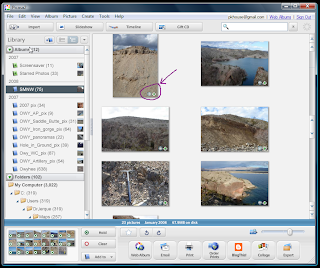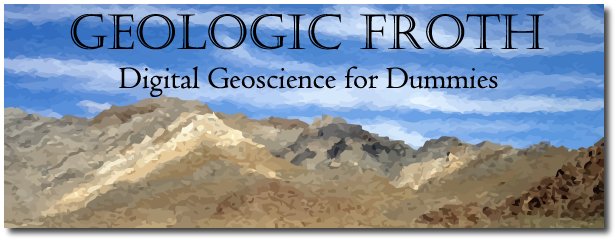Are you the creator of an intricate directory structure in which you try to keep track of your digital photos? Have you actually saved multiple copies of a photo in order for it to be represented in relevant folders? I was once such a fool. For several years now, though, I have been using
Picasa, a free and simple photo organizing program that allows you to tag your photos with key words instead of storing them in directories with key names. This turns out to be an extremely useful application if you have lots of digital photos. Tagging items with key words is superior to elaborate directory structures. Consider the following situation: You have a photo of a key outcrop in a specific map area that conveys multiple types of information. You can store that photo in a directory that is keyed to that map area and hope to remember that it also contains information relevant to other areas or geologic concepts.
Example from my work: Spirit Mtn. Northwest quad; Colorado River Sediment; Bullhead alluvium; erosional unconformity; sediment sample location.
What to do with this much information? By using tags in
Picasa, I can store one copy of this image in a directory of my choice, but then tag it with all of those labels (likely shorthand versions like SMNW; Tcb; Unf; SSamp) so that all I have to do is search on the tag to find the image. Easy? Yes.
 Picasa
Picasa isn't the only program that does this, but I use it exclusively because I can so easily then link the photos with Google Maps, Google Earth, and any of my blogs (also, it is free). Be sure to check out the related post about geotagging photos and displaying them in a Picasa Web Album. The preceding screen-snag of the interface shows the basic layout. The circled area shows a compass rose icon indicating that the image has been geotagged and an arrow that indicates that it has been uploaded to a Picasa Web Album where the photos can be viewed in relation to the point from which they were taken in the field.
It should take you only 30 minutes to figure out how to use the program. Note that it will automatically search your computer for images and if offers some basic image editing functionality.
 A colleague at NBMG recently turned me on to a very handy program from the Minnesota Department of Natural Resources that easily converts GPS tracklogs and waypoints to shapefiles to use in GIS software. The program is called DNR Garmin and is extremely handy. Kudos to the author. The program can suck data right off the unit or can read from a gpx file. The image above is proof that it works.
A colleague at NBMG recently turned me on to a very handy program from the Minnesota Department of Natural Resources that easily converts GPS tracklogs and waypoints to shapefiles to use in GIS software. The program is called DNR Garmin and is extremely handy. Kudos to the author. The program can suck data right off the unit or can read from a gpx file. The image above is proof that it works.






